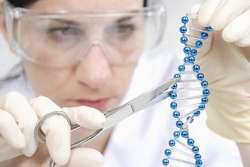For first time ever, scientists are able to edit DNA in human embryos through CRISPR technique!
CRISPR-Cas9 operates like a molecular scissor which can selectively incise unwanted parts of the genome and replace it with the healthy new strands of DNA.

In a recent breakthrough, US scientists have been able to modify genes of a human embryo to correct a disease-causing mutation. This new discovery has made it possible to prevent the genetic defects being transferred to future generations. This milestone was confirmed last week by Oregon Health and Science University (OHSU), which collaborated with the Salk Institute and Korea’s Institute for Basic Science to use a technique known as CRISPR-Cas9 to correct a genetic mutation for hypertrophic cardiomyopathy.
The studies have been published using the technique in China with mixed results. CRISPR-Cas9 operates like a molecular scissor which can selectively incise unwanted parts of the genome and replace it with the healthy new strands of DNA.
Also Read: Dynamic DNA prevents gene damage: Study says
"We have demonstrated the possibility to correct mutations in a human embryo in a safe way and with a certain degree of efficiency," said Juan Carlos Izpisua Belmonte, a professor in Salk's Gene Expression Laboratory and a co-author of the study.
To enhance the success rate, his team introduced the genome editing components along with sperm from a male with targeted gene defect during the IVF technique. They deduced that the embryo used the available healthy copy of gene to repair the disease-causing mutated part.
The Salk/OHSU also found that that its gene rectification did not cause any significant mutations in the other sections of the genome, which was the major concern for gene editing. But still the technique wasn’t cent per cent successful. It hiked the number of repaired embryos from 50 per cent, which could have occurred naturally, to 74 per cent. The embyos tested in laboratory, were allowed to flourish for only a few days.
Also Read: Which facial features are mostly inherited from parents
"There is still much to be done to establish the safety of the methods, therefore they should not be adopted clinically," Robin Lovell-Badge, a professor at London's Francis Crick Institute who was not involved in the study, said in a statement.
Washington’s National Academy of Sciences (NAS) earlier in 2017 dropped its previous resistance to the use of gene editing technology in human embryos, which has raised concerns it can be later used to create designer and customized babies. There was also a concern regarding introduction of unwanted further mutations into the genome.
"No one is thinking about this because it is practically impossible at this point," Izpisua Belmonte said. "This is still very basic research ... let alone something as complex as what nature has done for millions and millions of years of evolution."
An international group of 11 organizations, which included the American Society of Human Genetics and Britain's Wellcome Trust, issued a policy on Wednesday suggesting against the genome editing that might end up in human pregnancy, while backing publicly funded research into its potential use in clinical applications.
Salk's Izpisua Belmonte emphasised on the fact that more study was needed about the subject. The most important practical application of genome editing would be in correcting unwanted genetic mutations in babies in uterus or just after they’re born.
"It is crucial that we continue to proceed with the utmost caution, paying the highest attention to ethical considerations," he said.
For more lifestyle news, follow our Facebook page